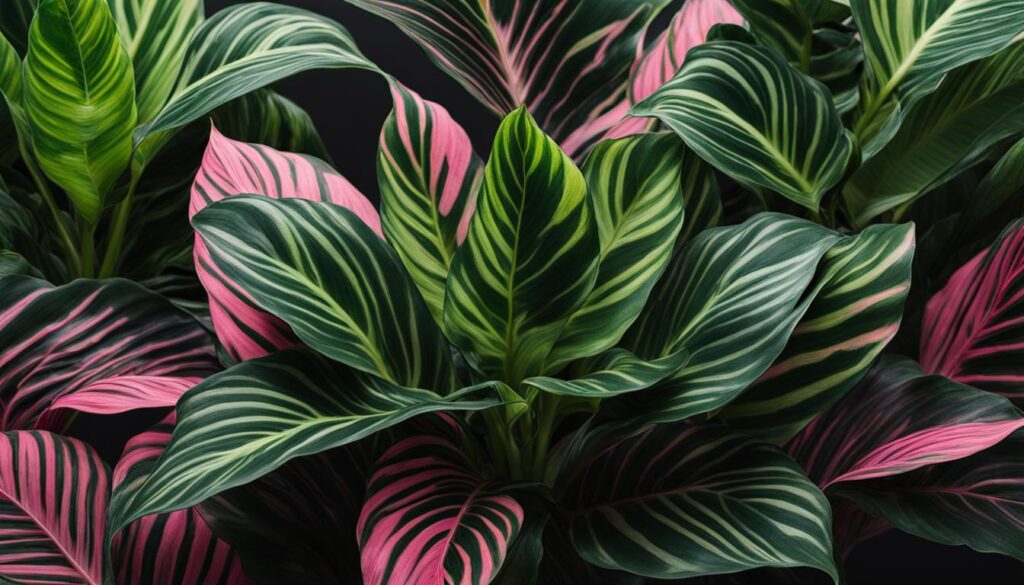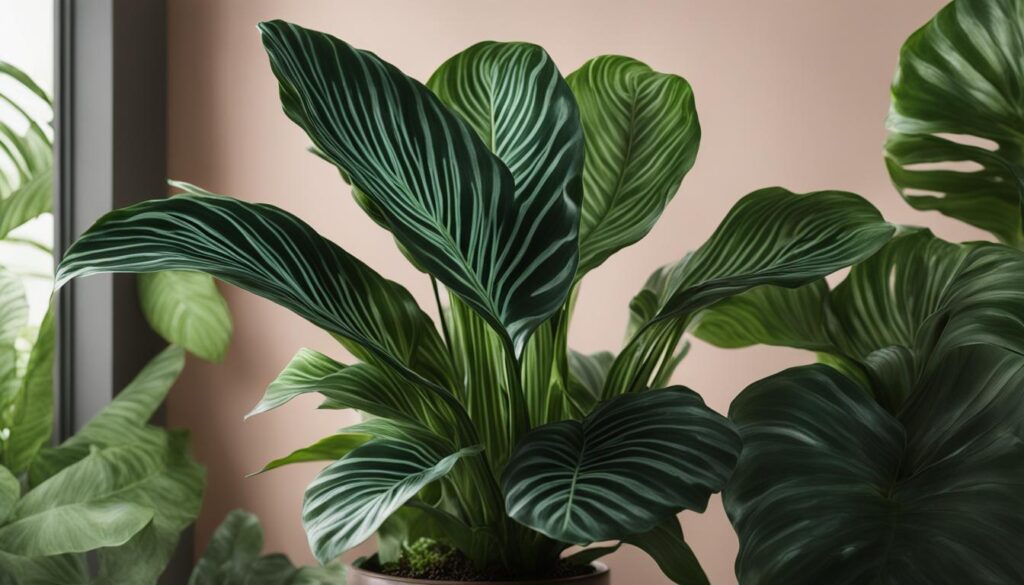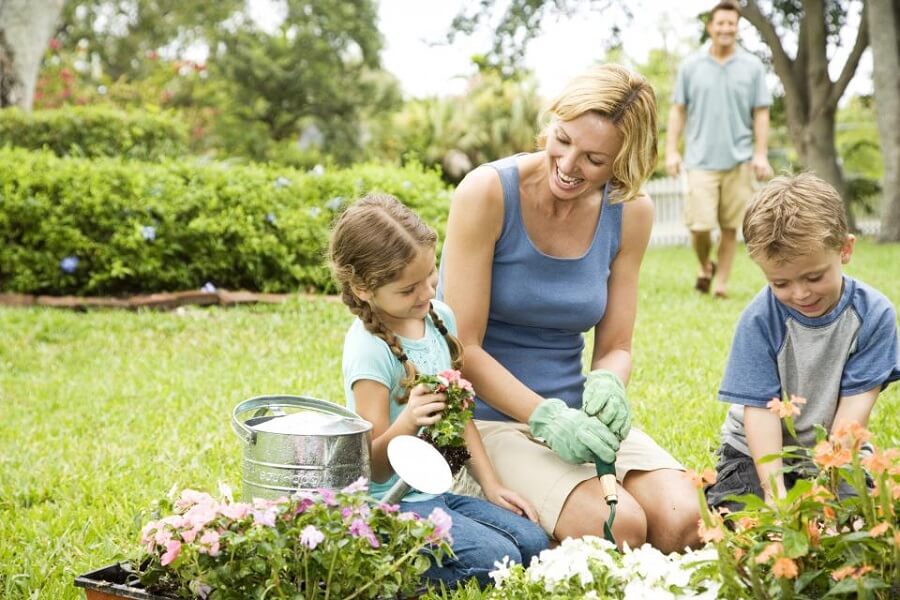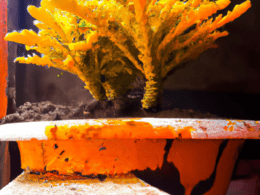If you’re a plant enthusiast striving to ensure optimal Calathea Ornata care, it’s important to address issues such as leaves curling to maintain plant health and vibrancy. Detecting the causes of leaf curling and implementing effective houseplant solutions will help you tackle common Calathea leaf problems efficiently.
Key Takeaways
- Leaf curling in Calathea Ornata is a sign of distress and can be caused by various factors.
- Understanding the natural leaf movements of Calathea Ornata is essential for providing proper care.
- Optimal light exposure, temperature, and humidity conditions are crucial for maintaining a healthy Calathea Ornata.
- Striking the right balance in watering practices prevents both over- and underwatering-related leaf curling incidents.
- Ensuring optimal water quality can play a significant role in preventing leaf-tip browning and curling.
Understanding Calathea Ornata’s Unique Leaf Movements
The Calathea Ornata is known for its expressive foliage and unique leaf movements that not only add to the plant’s visual appeal but also serve a functional purpose. In order to properly care for this fascinating houseplant, it’s important to recognize and understand both its natural leaf positions and its movements in response to environmental conditions.
One of the most captivating features of Calathea Ornata is its ability to follow the sun’s position for energy conservation. The plant will alter its leaf positions to optimize its exposure to sunlight, allowing it to efficiently absorb energy throughout the day. These unique leaf movements can vary depending on several factors, including the time of day and the plant’s surroundings.
Calathea Ornata also has a distinct nightly routine, known as nyctinasty, where its leaves become upright during the evening. This natural nighttime posture differs from the curling of leaves, which indicates a plant’s response to adverse conditions and is not part of its regular physiological behavior.
To help distinguish natural leaf positions from reactions to environmental stressors, consider the following key differences:
- Leaf curling: In response to factors such as inadequate light, temperature, or humidity, a Calathea Ornata may curl its leaves to conserve energy and moisture, and protect itself from damage.
- Nyctinasty: As part of its normal night-time behavior, Calathea Ornata’s leaves will lift and close in an upright position, providing a clear distinction from leaf curling.
As a Calathea Ornata owner, it’s essential to monitor your plant’s leaf movements regularly and make any necessary adjustments to its care routine to address potential stressors. By doing so, you will not only promote its overall health but also allow it to display its captivating, expressive leaf positions throughout the day and night.
Light Exposure: Finding the Sweet Spot for Your Calathea Ornata
To ensure the health and beauty of your Calathea Ornata, it is essential to understand its Calathea light requirements. As a jungle-dwelling plant, the Calathea Ornata thrives under indirect light conditions, which closely resemble the dappled shade it experiences in its natural habitat beneath the forest canopy.
Direct sunlight can lead to leaf scorch, fading of the plant’s distinct patterns, and impair your Calathea’s energy absorption capabilities. To create ideal lighting conditions and prevent leaf curling, you must strike the right balance between bright and indirect light.
Finding the Ideal Plant Location
When scouting for the perfect spot for your Calathea Ornata, consider the factors that may affect the light it receives. East-facing windows often provide an ideal balance of light intensity and duration – enough to meet the plant’s energy needs without causing leaf damage by overexposure.
Northern windows typically offer less sunlight, making them suitable for areas with intense sunshine. Conversely, avoid placing your Calathea near south or west-facing windows, as the intense, direct light may result in scorching.
- Position your Calathea Ornata in a well-lit room with north or east-facing windows.
- Always shield the plant from direct sunlight by using sheer curtains or blinds.
- Utilize distance from windows or artificial light sources to maintain consistent ambient lighting.
- Rotate the plant regularly to promote even growth and exposure to light.
Adjusting Light Exposure for a Healthier Calathea Ornata
If you suspect that leaf curling is a result of excessive light exposure, immediately relocate the plant to a spot with filtered light. Observe the plant’s response to the new plant location over the next several weeks – this critical period will reveal if adjustments are needed to optimize your Calathea’s light conditions.
| Signs of Inadequate Light | Signs of Excessive Light |
|---|---|
| Leggy growth and long stems | Burnt leaf edges and faded patterns |
| Leaves growing smaller than usual | Leaves becoming pale and washed out |
| Slow to no new growth | Leaves curling and becoming crispy |
By adjusting the light exposure to align with your Calathea Ornata’s needs, you can prevent leaf curling and promote vibrant, healthy plant growth. This way, your Calathea will thrive and remain a stunning and dynamic addition to your indoor garden.
Temperature Fluctuations: Keeping Your Calathea Cozy
Calatheas, being tropical houseplants, thrive best in a warm environment. As for the Calathea Ornata temperature range, it prefers indoor temperatures between 19°C and 29°C (66°F and 84°F). Maintaining these ideal conditions throughout the year is crucial to keep your Calathea Ornata healthy, and prevent the occurrence of leaf curling due to temperature fluctuations.
Take measures to protect your Calathea Ornata from cold draughts, especially in the winter months. Excessively open windows and close proximity to air conditioning units can increase the risk of temperature-related leaf curling. To optimize the temperature for your Calathea, consider the following precautions:
- Position your plant away from windowsills in winter
- Avoid placing it near direct sources of cold air currents, such as air conditioning vents
- Monitor indoor temperature using a thermometer to ensure it remains within the desired range
As you might expect from a tropical plant, Calathea Ornata is sensitive to sudden temperature changes and extreme conditions. In addition to those precautions, ensure the plant is not moved between locations with significantly different temperatures in a short period.
By maintaining a comfortable and stable temperature in your home, you can effectively prevent leaf curling, promoting a healthier, thriving Calathea Ornata. This not only contributes to the plant’s overall well-being but also enhances the natural beauty it brings to your indoor space.
Maintaining Ideal Humidity for Calathea Ornata
Calathea Ornata thrives in humidity levels reflective of its tropical origins. Without adequate humidity, leaves can curl up to reduce moisture loss, resulting in dry leaves and hindered moisture absorption. To ensure optimal plant health and growth, it is vital to maintain indoor humidity levels suitable for Calathea Ornata, which can be achieved through a combination of short-term quick fixes and long-term solutions.
Quick Fixes for Low Humidity Challenges
When faced with low humidity levels, immediately rehydrating the foliage of your Calathea Ornata becomes essential. One quick fix for this issue is misting the leaves, which can provide a temporary increase in the surrounding moisture levels. This method serves as a short-term solution for humidity challenges and can significantly aid in preventing further leaf curling.
Long-Term Solutions for Humidity Control
While quick fixes are helpful for immediate relief, it is crucial to establish long-term solutions for maintaining consistent humidity levels in your plant’s environment. Implementing one or more of the following methods can significantly improve the humidity control for your Calathea Ornata:
- Investing in a humidifier: A humidifier can be an effective long-term solution for maintaining optimal humidity levels in your indoor living space. Various types of humidifiers cater to different room sizes and preferences, offering flexibility as you choose the one best suited for your plant’s needs.
- Utilizing a pebble tray: Placing your Calathea on a tray filled with pebbles and water can help increase the humidity levels immediately surrounding the plant. As the water evaporates, the moisture is absorbed by the plant, creating a microclimate of increased humidity.
- Relocating your Calathea: If you have a naturally humid room in your home, such as a bathroom or kitchen, moving your Calathea Ornata there can provide a more suitable long-term environment for the plant’s humidity needs.
By incorporating a combination of quick fixes and long-term solutions, you will be able to maintain ideal humidity conditions for your Calathea Ornata, resulting in healthier foliage and a thriving plant.
Watering Practices: Striking the Right Balance
Regulating watering is vital for Calathea Ornata‘s health. The soil should remain consistently moist while avoiding waterlogging. Monitoring topsoil dryness and adopting a less frequent watering schedule during dormant winter months can prevent leaf curling associated with both under and overwatering. Proper watering practices will help you maintain the soil moisture balance, prevent root rot, and determine the optimal watering frequency.
To prevent overwatering, it’s crucial to understand the signs of excessive moisture in the soil. Signs of overwatering your Calathea Ornata include:
- Yellowing leaves
- Wilting despite wet soil
- Root rot
- Soft, mushy leaves
On the other hand, underwatering can cause the following symptoms:
- Wilting of leaves
- Brown and crispy edges on leaves
- Leaf curling
- Slow growth
To strike the right balance between underwatering and overwatering, use these guidelines:
- Water when the top 1-2 inches of the soil is dry to the touch.
- Avoid letting the soil dry out completely, as this can cause stress on the plant.
- Reduce watering during the winter months, as the plant’s growth slows down and requires less water.
- Use a well-draining soil mix and an appropriate-sized pot with drainage holes to prevent waterlogging and root rot.
Monitoring your Calathea Ornata’s soil moisture and adjusting your watering frequency accordingly can help ensure a healthy, vibrant plant.
The Importance of Water Quality for Calatheas
Calathea Ornata can be sensitive to chemicals present in tap water, which may lead to mineral buildup, leaf-tip browning, and curling. Understanding the importance of water quality is essential for maintaining the health of your Calathea plants.
Mineral and Chemical Considerations for Calathea Care
Using filtered or bottled water at room temperature can help mitigate the effects of adverse chemicals, such as chlorine, fluoride, and salts, that may cause damage to your Calathea. Since these plants are tropical in origin, they are not used to the chemicals often present in tap water, and these substances can have a negative impact on their overall health.
Some methods to maintain good water quality for your Calathea include:
- Using a water filtration system or bottled water
- Collecting rainwater for watering purposes
- Allowing tap water to sit for a few hours to evaporate chlorine before using
By choosing one or more of these methods, you can prevent leaf curling and ensure healthier foliage for your Calathea Ornata.
Another important aspect of maintaining water quality is to regularly flush the soil of your Calathea plants. This helps to remove excess salt buildup from any fertilizers or tap water used, ensuring an optimal environment for your plants to thrive.
| Water Quality Aspect | Recommendation |
|---|---|
| Water Filtration | Use a water filtration system or bottled water |
| Rainwater Collection | Collect and store rainwater for watering Calatheas |
| Chlorine Evaporation | Allow tap water to sit for a few hours to evaporate chlorine |
| Soil Flushing | Regularly flush soil to remove excess salt buildup |
Ensuring optimal Calathea water quality will greatly contribute to the overall health of your plant. By avoiding the problems associated with tap water, such as mineral buildup and root temperature shock, you can provide the proper care your Calathea Ornata needs to flourish.
How Can I Stop My Calathea Leaves from Curling and Turning Brown?
If your calathea leaves are curling and turning brown, it might be due to underwatering or low humidity. To prevent this, make sure to keep the soil consistently moist and consider using a humidifier or placing a water tray near the plant. Keep an eye on your calathea leaves curling to ensure they stay healthy.
Conclusion
Proper care is crucial in ensuring a thriving Calathea Ornata, and by understanding the causes of leaf curling, you can take preventative measures to maintain your plant’s health. By adjusting care routines and creating an environment that reflects the plant’s natural habitat, you can promote plant recovery and restore your Calathea Ornata to its vibrant state.
Expert care tips for a healthy Calathea Ornata include providing the appropriate amount of indirect light, maintaining stable indoor temperatures, managing humidity levels, and ensuring proper watering practices. Additionally, paying attention to water quality and the potential effects of tap water on your plant can make a significant difference in preventing leaf curling and other foliage issues.
By following the expert advice provided in this article, you can address the specific needs of your Calathea Ornata and help create a thriving indoor garden. With time, patience, and dedication to proper care, you can enjoy the beautiful, expressive foliage of your healthy houseplant for years to come.











